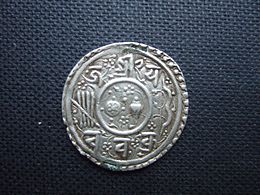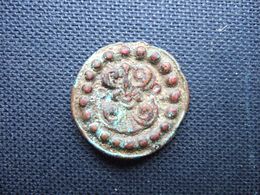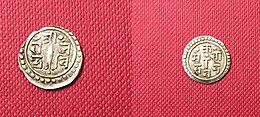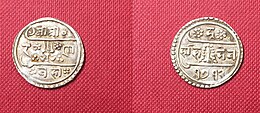Coinage of Nepal
| Part of a series on |
| Numismatics the study of currency |
|---|
 |
The earliest coin minted in today's territory of Nepal was in Shakya Mahajanapada, along the India–Nepal border at around 500 BCE. Shakya coins were an example of a coin invented in the Indian subcontinent which continued to be used in Nepal alongside India for over 1500 years.[1]
Coins from Indian Subcontinent
Post-Maha Janapadas period (c. BCE 600–?)

In the Maurya Empire, punch marks were widely used in the southern region of Nepal and also imported from hills and the Kathmandu valley. Mauryan coins were punch-marked with the royal standard to ascertain their authenticity.
Kushan Empires (c. CE 30–375)

Another major coinage found in Nepal was of the
Classical period of Nepal (c. CE 576–750)
Lichhavi Dynasty

The
Medieval period (c. CE 750–1540)
The coinage in the Medieval period of Nepal is largely unknown due to the lack of references and contemporary records about it. Scholars believe that the most likely explanation is that
Malla Dynasty (c. CE 1540–1768)
A new coinage system developed in Nepal, especially in the Kathmandu valley and surrounding hills during the Malla (Nepal) of Nepal. These coins were struck by the sons of Yakshya Malla (c. CE 1482) in separate kingdoms of Kathmandu, Bhadgaon, Patan and by Kings of Dolakha and Gorkha. The usual design on the coins, perhaps suggested by some of Akbar's and Jahangir's issues, consists of elaborate geometrically ornamented borders surrounding a central square or circle, with the legends in Nāgarī script fitted into the spaces left in the design. On the obverse appear the king's name, titles, and date, and on the reverse various symbols, accompanied sometimes by a further title or a religious formula.
Tankas Standard
Tankas or Tanka were mostly debased silver coin struck in 10 g. weight with minor denominations of 1⁄4, 1⁄32, 1⁄128, 1⁄512 Tanka Dam. These coins were based on the designs of
Mohar Standard
After a major reform in coinage, a new style of silver coins called Mohar (Initially called Mhendramalli) were struck in Nepal with a reduced weight standard of 5.4 g. in silver. All three kingdoms of the Kathmandu valley along with the Gorkha Kingdom struck these coins with little modification until after the unification of Nepal by King Prithvi Narayan Shah (1723–1775). These coins were struck in the new artistic design of Hindu-Buddhist Yantra and were struck in the denominations of 1⁄4 Mohar called Mohar Suki (Generally in the name of the Queen) and 1⁄128 Mohar called Mohar Dam. They were struck with the date in Nepal Sambat and with a date in which the issuing king was crowned rather than the date of issue.[4]
Shah Dynasty (CE.1747–2008)
Prithvi Narayan Shah before the conquest of the Valley
Before the conquest of the Kathmandu Valley,
After the conquest of the Valley
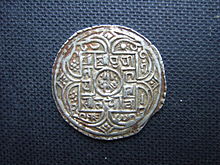
After the conquest of Kathmandu Valley, King Prithivi Narayan Shah withdrew all the old Malla currency and in order to stop their circulation, devalued their exchange rate. Apart from the regular issue of Mohar,
Regent Queen
Several Suki coins were issued by the Regent Queens of Shah dynasty due to a power shift in the court. In Sak.1722 Queen Raj Rajeshwari Devi senior wife of Rana Bahadur Shah issued her own suki currency as a regent of infant King Girvan Yuddha Bikram Shah followed by her successor regent Suwarna Prabha Devi (Sak.1723). Followed by Raja Rajeshwari Devi again in Sak.1724 and Probably with different names (Amar Rajeshwari and Mahamaheshwari).[5]
Copper coinage in Valley
In CE. 1865, the first copper coins were issued for the Kathmandu Valley in the denomination of Copper Paisa, Double Paisa and Dam with inscription in Devanagari script.[4]
System
Tanka standard
- 1 Tanka
- 1⁄4 Tanka
- 1⁄32 Tanka = 4 Dam
- 1 Dam= 4 Jawa
Silver Mohar system (after 1640)
- Double Rupee = 4 Mohar
- 1 Rupee /Double Mohar = 2 Mohar
- 1 Mohar = 2 Suka
- 1 Suka = 6.25 Aana
- 1 Aana = 2 Adha-aana
- 1 Adha-aana = 2 paisa
- 1 Paisa Mohar = 4 Dams
- 1 Dam = 4 Jawa
Copper standard
- 1 Ganda or Ani/Aana = 2 Dyak or 2 Double Paisa
- 1 Dyak or 1 Double Paisa = 2 Dhebua or 2 Paisa
- 1 Dhebua/Paisa = 4 Dam(Copper)
Gold coin system
- Duitole troy grains
- Bakla Asarfi = 2 Mohar = 1 Tola = 180 troy grains
- Patla/Majhawala Asarfi = 1 Mohar = 1⁄2 Tola = 90 troy grains
- Suka Asarfi = 1⁄2 Mohar= 1⁄4 Tola = 45 troy grains
- Suki = 1⁄8 Mohar= 1⁄16 Tola = 22.5 troy grains
- Ani = 1⁄16 Mohar = 1⁄32 Tola = 2.93 troy grains
- Adha-Ani = 1⁄32 Mohar = 1⁄64 Tola = 5.87 troy grains
- Pal = 1⁄64 Mohar = 1⁄128 Tola = 2.93 troy grains
Gallery
-
Nepalese silver mohar in the name of king Chakravartendra Malla of Kathmandu, dated Nepal Sambat 789 = AD 1669, obverse
-
Nepalese silver mohar in the name of king Chakravartendra Malla of Kathmandu, dated Nepal Sambat 789 = AD 1669, reverse
-
Copper coin of Jishnu Gupta (c. 622–633) of the Nepalese Licchhavi Dynasty. Reverse
-
Gunanka.
-
Half Mohar Rajendra Vikrama
-
Suka Mohar Rajendra Vikrama in the name of Queen Samrajya lakshmi.
-
1-8 Mohar Rajendra Vikrama
-
Half Mohar Rana Bahadur Shah
-
Uni-face Silver Dam Girvana Yuddha.
-
Rana Bahadur 1 paisa.
-
Rana Bahadur Half paisa.
-
Obverse of a 10 Paisa coin of Nepal from the reign of Mahendra Bir Bikram, made of brass.
See also
External links
- "Notes and Coins of Nepal" (PDF). Nepal Rastra Bank. Archived from the original (PDF) on 26 February 2012. Retrieved 24 November 2016.
References
- ^ "The COININDIA Coin Galleries: Shakya Janapada". Coinindia.com. Retrieved 22 May 2012.
- ^ http://www.kushan.org/general/other/part1.htm Archived 2015-07-07 at the Wayback Machine and Si-Yu-Ki, Buddhist Records of the Western World, (Tr. Samuel Beal: Travels of Fa-Hian, The Mission of Sung-Yun and Hwei-S?ng, Books 1–5), Kegan Paul, Trench, Trubner & Co. Ltd. London. 1906 and Hill (2009), pp. 29, 318–350
- ^ Falk (2001), pp. 121–136. Falk (2004), pp. 167–176.
- ^ ISBN 978-0-901405-27-2.
- ^ OCLC 652243631.
- ^ American Journal of Numismatics. American Numismatic Society. 1917. pp. 231–.

